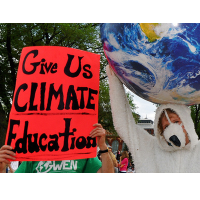Nation’s Science Teachers Found to Have Poor Grasp of Climate Change
 (photo: MV Jantzen, Creative Commons)
(photo: MV Jantzen, Creative Commons)
By John Schwartz, New York Times
Most science teachers in the United States spend some time on climate change in their courses, but their insufficient grasp of the science as well as political factors “may hinder effective teaching,” according to a nationwide survey of the profession.
The survey, described in the current issue of the journal Science, found that teachers spent little time on the topic — just one to two hours on average over an academic year.
“It’s clearly not enough time to really provide students with a good scientific understanding,” said Eric Plutzer, the lead author of the paper and a professor of political science at Pennsylvania State University.
Many teachers also provide misinformation about climate change, the survey found. The evidence that human activity is a major cause of recent climate change is overwhelming, but 30 percent of the 1,500 teachers surveyed said they emphasize that recent global warming “is likely due to natural causes,” while 12 percent said they did not emphasize human causes. Half of that 12 percent said they did not discuss any causes at all.
Close to a third of the teachers also reported conveying messages that are contradictory, stressing both the scientific consensus on human causation and the idea that many scientists believe the changes are due to natural causes.
The authors of the paper suggested that those teachers “may wish to teach ‘both sides’ to accommodate values and perspectives that students bring to the classroom.” The survey also found, however, that only 4.4 percent of teachers said that they had experienced overt pressure from parents, school administrators or the community to teach about climate change.
Plutzer, who is the academic director of Penn State’s survey research center, said that he and his colleagues were surprised by the level of ignorance the teachers showed in the survey, especially in describing the current state of scientific consensus on the topic.
More than 95 percent of climate scientists agree that recent global warming is caused mostly by human activity, but only 30 percent of middle school teachers and 45 percent of high school teachers correctly identified the degree of consensus as 81 percent to 100 percent.
The research team, which collaborated on the project with the National Center for Science Education, surveyed 1,500 teachers from high schools and middle schools in all 50 states.
Josh Rosenau, the programs and policy director for the science education center, said that he found it “encouraging” to see how many teachers were spending at least some time on climate change.
“Coming into it, we expected the number to be a lot lower than it was,” he said. And while the teachers might not be reporting a great deal of overt pressure, he said, “The broader environment that they are living in is shaping how willing they are to be forthright about the science.”
Bertha Vazquez, a teacher in Miami who incorporates climate change climate issues into their courses.
The lack of knowledge of the science is understandable, Plutzer said, because “very few current teachers had much exposure to climate science when they were in college.”
Climate change is still not often part of a formal curriculum, so the instruction in one year rarely can add to the previous year’s work, Plutzer added. And teachers feel pressured to focus more intensely on topics that appear on “high-stakes tests” that define much of today’s educational process, he said.
The evolving nature of climate science means continuing teacher education is essential, said Rosenau of the science education center.
“If you graduated college in the 1990s and are teaching evolution the way it was taught when you were in school, you’re not doing anything wrong,” he said. “If you’re teaching climate change the way you learned it in the 1990s,” when the role of human activities and burning of fossil fuels was less clear, “you’re kind of teaching climate change denialism.”
Still, climate science has increasingly become part of lesson plans, and is likely to become more prominent.
The Next Generation Science Standards developed several years ago by 26 states, while not providing a specific curriculum, serve as guidelines that describe what students should learn in science classes.
The standards have been adopted by 16 states and the District of Columbia, but have a wider influence, since many school districts around the country have independently adopted the standards.
Rosenau said that the spread of the standards to states that include more than half of the nation’s students mean that textbook publishers will be more likely to include information about climate change in books and teacher training materials distributed nationwide.
“In the long run, it’s going to affect everybody,” he said.
Craig Whipkey, a high school science teacher in western Pennsylvania, said he devoted about two weeks of instruction to discussing climate change in each of his three courses. While he occasionally receives pressure from parents, he said, he teaches from the perspective that evidence of human effects on climate change is compelling.
“I no longer have to prove that it’s happening,” he said. Instead, the focus is, “Here’s what the ramifications are going to be.”
To Learn More:
California Sixth–Grade Science Books on the Fence over Climate Change (by Ken Broder, AllGov California)
- Top Stories
- Unusual News
- Where is the Money Going?
- Controversies
- U.S. and the World
- Appointments and Resignations
- Latest News
- Trump to Stop Deportations If…
- Trump Denounces World Series
- What If China Invaded the United States?
- Donald Trump Has a Mental Health Problem and It Has a Name
- Trump Goes on Renaming Frenzy






Comments